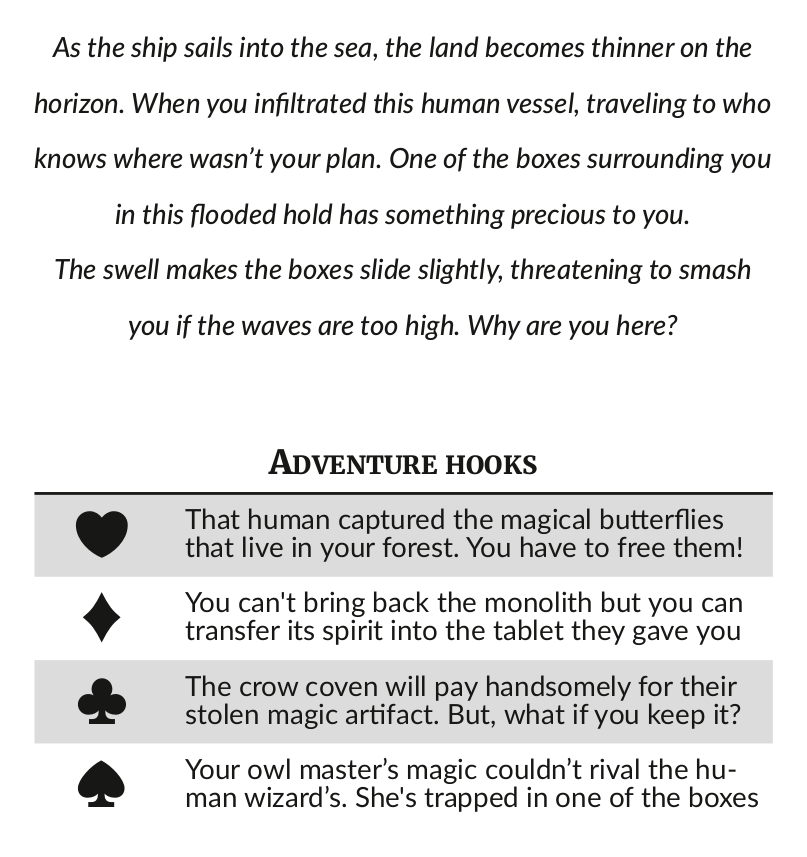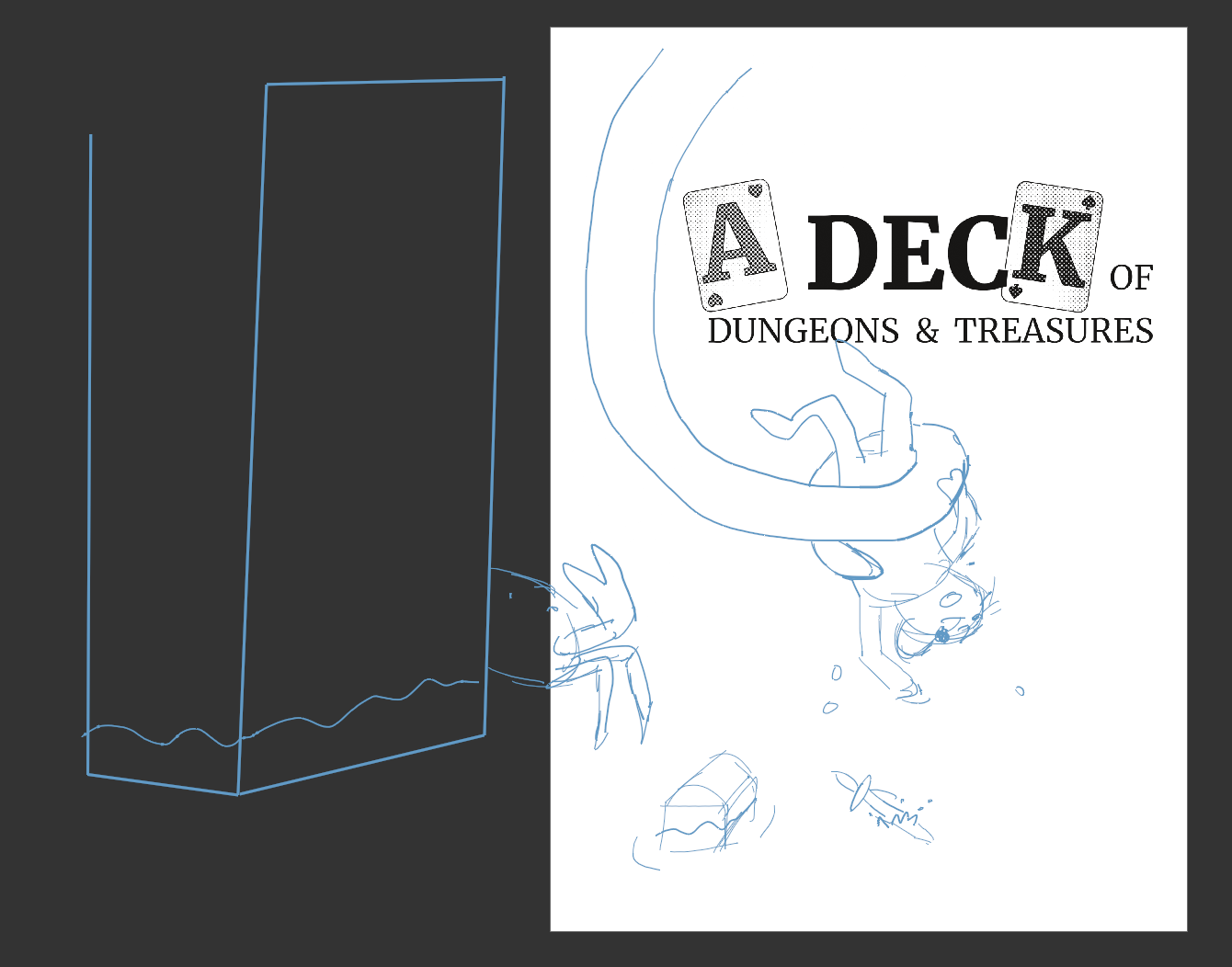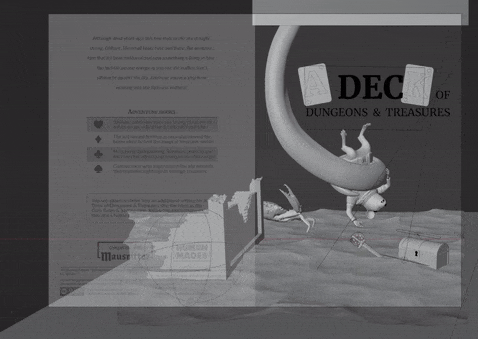#1 Arcane Cargo II: the Design
While I'm finishing up the second setting, I want to publish the second of three posts about Arcane Cargo that I had left in a drawer. This time I talk about the design decisions.
The idea
Like every setting in More Dungeons & Treasures, Arcane Cargo comes from the idea of one of the backers of the original crowdfunding campaign. Dillon Brown, like 8 other backers, got a reward whose only perk was to share a setting with every other backer based on his idea.
It was pretty concise: the adventure takes place in the cargo hold of a magic merchant's trading ship, the rooms being the crates. This last part came with some design changes and decisions that will be discussed next.
A reason to enter the boxes
A central part of the design, from the player’s side, was making sure they would want to enter the boxes. The idea of isolated, enclosed rooms may clash with the gameplay if the player could just skip almost everything altogether. How did I solve it?
First, the back cover synopsis insists that you are looking for something inside the boxes. Second, the hook table gives you more motivation to do it—the butterflies from your forest, someone trusted you with regaining the monolith’s spirit, your owl master was kidnapped, or maybe you just want for yourself whatever the crows wanted you to retrieve for them.
Luring the players into the boxes with treasure was easy, but the problem was prominent with obstacles and traps. Why would you want to enter a box full of pointy barnacles? The space for the rooms’ text is just too small so a general justification was the better call. You enter the room and inspect it in case your character’s goal is in there although you, as a player, know that is not already there.

Getting the most from the setting
Whether mine or the backers’, I try to exploit the idea behind each setting as much as possible. Sometimes the inspiration comes out logically: the idea of the boxes led to the corridors. Then the corridors led to make them more interesting by making the boxes slide.
The addition of the water was a logical one too: if I wanted sea creatures wandering around, I needed some water; which later led to another idea.
An unexpected idea: the water level
Although I’ve experimented with water levels before, I wasn’t planning on doing it this time. But in my search for 9 Obstacles, I came up with the idea of the water as an obstacle. The water rises, so now it's harder to walk through the hold. Then, I thought that being unable to get the water at the base level again was unfair to the player, so it occurred to me to add a drain. But then I thought that a 1/52 chance of finding the water-rising obstacle didn’t merit adding a 1/52 chance of a drain. So I made it a mechanic.
In the end, a total of 3 boxes can raise the water level, and 3 drains were added to the Empty cards. The initial idea was 4 and 4, but this decision was made later on and I wasn’t able to discard any of my Traps ideas. In addition, as mechanics work better if they affect different aspects of the gameplay, I made the water level affect the big creatures (Creature C) alternatively hindering the cat or the octopus.
The only part left was communicating to the player about the default water level which I did with the cover art.


Why only two creatures
Most settings feature four new creatures, but I knew that the box-sliding mechanic would need more space from the Notes page as some pictures were needed. After some thought, I decided to scrap two creatures and have that extra space on the page.
Also, I knew one “encounter” would be the boxes sliding, so I would need fewer creatures. Initially, I planned to have the sliding boxes as the #6 encounter and not have a Creature C but later I decided that 1-in-6 chances were too low. That would make the B-type creatures disappear, making the creatures in this setting poorer diversity-wise. The compromise was to have type-B creatures appearing in the rooms, but not in random encounters. And, as I wanted to save space, these creatures were all the aquatic ones you can find in Mausritter’s manual.

Get More Dungeons & Treasures (Eng. Ed.)
More Dungeons & Treasures (Eng. Ed.)
🇬🇧🇺🇸A collection of procedural settings for Mausritter
| Status | In development |
| Category | Physical game |
| Author | BuchPlays |
| Genre | Role Playing |
| Tags | cards, deck, GM-Less, mausritter, OSR, Solo RPG, Tabletop role-playing game |
More posts
- #2 Escape from the Lab I: Release NotesFeb 28, 2025
- #1 Arcane Cargo III: a Tale from a Gameplay TestFeb 21, 2025
- #1 Arcane Cargo I: ClarificationsSep 11, 2024

Leave a comment
Log in with itch.io to leave a comment.